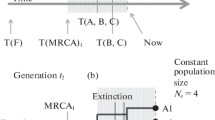Abstract
The present data illustrate an important characteristic of the mate recognition system of individuals ofDrosophila melanogaster. This system showed a high degree of stability, and the stability occurred even though the populations under investigation were divergent in other characteristics. We review the results of other studies of this type, discuss our results in terms of the general characteristics of specific-mate recognition systems, and account for its stability in terms of the structure of the communication system.
Similar content being viewed by others
References
Ehrman, L. (1972). Rare male advantage and sexual isolation inDrosophila immigrans.Behav. Genet. 2:79–84.
Ehrman, L., and Parsons, P. A. (1980). Sexual isolation among widely distributed populations ofDrosophila immigrans.Behav. Genet. 10:401–407.
Henderson, N. R., and Lambert, D. M. (1982). No significant deviation from random mating of worldwide populations ofDrosophila melanogaster.Nature 300:437–440.
Knibb, W. R., Oakeshott, J. G., and Gibson, J. B., (1981). Chromosome inversion polymorphisms inDrosophila melanogaster. I. Latitudinal clines and associations between inversions in Australian populations.Genetics 98:833–847.
Molin, C. D. (1979). An external scent as the basis for a rare male mating advantage inDrosophila melanogaster.Am. Nat. 113:951–954.
Oakeshott, J.G., Chambers, G.K., Gibson, J. B., and Willcocks, P.A. (1981). Latitudinal relationships of esterase-6 and phosphoglucomutase gene frequencies inDrosophila melanogaster.Heredity 47:385–396.
Paterson, H. E. (1978): More evidence against speciation by reinforcement.S. Afr. J. Sci. 74:369–371.
Paterson, H. E. (1980). A comment on “mate recognition systems.”Evolution 34:330–331.
Paterson, H. E. (1981). The continuing search for the unknown and unknowable: A critique of contemporary ideas on speciation.S. Afr. J. Sci. 77:113–119.
Author information
Authors and Affiliations
Additional information
Publication No. 15 Evolutionary Genetics Laboratory, University of Auckland.
Rights and permissions
About this article
Cite this article
Lambert, D.M., Henderson, N.R. The stability of the specific-mate recognition system ofDrosophila melanogaster . Behav Genet 16, 369–373 (1986). https://doi.org/10.1007/BF01071318
Received:
Accepted:
Issue Date:
DOI: https://doi.org/10.1007/BF01071318




